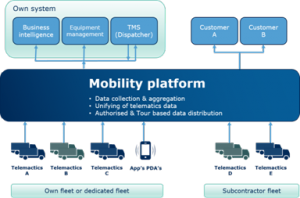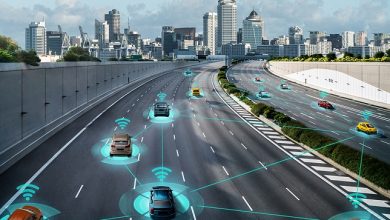2017– year for smart logistics connectivity?
This decade has already seen much written about the Internet of Things (IoT) revolution – soon, everything in homes, shops and will be connected. Businesses are revamping the way they operate to open new connected revenue streams, factories are becoming smart, and people are changing the way they work, rest and play.
 The transport industry is no exception. But it’s not just about having smart trucks or intelligent reefer containers on the road. The smart use of logistics data is just as. And there’s a growing mountain of data already flowing through diverse enterprise management and telematics systems about loads in transit on roads, ships and planes.
The transport industry is no exception. But it’s not just about having smart trucks or intelligent reefer containers on the road. The smart use of logistics data is just as. And there’s a growing mountain of data already flowing through diverse enterprise management and telematics systems about loads in transit on roads, ships and planes.
But, for many involved in the supply, when it comes to the smart use of data, we’re still in the dark ages and the dynamic era of connected logistics is long overdue.
Third-party (3PLs) and fourth-party logistics (4PLs) providers in particular are under greater pressure from customers than ever before to share data about tour information. When will a load arrive? Where is a particular shipment right now? What condition are they in? Why did a truck make an unscheduled stop? The need for real-time data has never been so to enterprises.
But there are obstacles on the way to connected nirvana. Today, the industry needs a mobility platform or data hub to manage inbound and outbound logistics data. And then there’s the problem of inter-connectivity of data. The supply chain uses so many different types of enterprise management systems and hauliers so many different types of telematics systems that it requires end-customers and transport managers to make massive investments in time and software to simply interpret logistics data.
“The industry is at a cross-road when it comes to visibility of inbound and outbound logistics data,” says Jesper Bennike, CEO, GateHouse Logistics. “We recently asked transport leaders for their views on the subject and 65% now consider there is an urgent need to share load data for greater efficiency and to cut transport costs. That percentage can only increase with time.”
So, the industry wants a mobility platform capable of handling different types of data as well as the sharing of data taking into consideration both to whom and when is the data relevant and who is allowed to see the data. It has to be relevant to data consumers both internally and externally to any organisation. The dispatcher is primarily interested in data about a shipment, the manager about technical data of the fleet, and the external customer of the logistics service provider is interested in data about specific loads.
As a leading independent logistics data unifier and aggregator, GateHouse believes that it is within its remit to propose a cross-system data mobility platform to the transport and logistics industry that not only collects and unifies all data from all telematics systems, but also distributes it based on an intelligent tour engine to authorised enterprises as one Datastream
“This platform could become the hub for the smooth flow of real-time tracking data between internal and external data consumers of the logistics service provider. Only authorised parties will receive data so the platform becomes data-relevant and data-specific to customers,” says Jesper Bennike, CEO, GateHouse Logistics.
As the industry moves into the connectivity era and becomes more efficient, the way data is presented by transport managers to their customers also takes on added. As it stands, enterprise management systems cannot cope with the volume of different data formats involved.
Take telematics data as an example. In an average supply, there are several hundred GPS systems being used by hauliers and their sub-contractors at any one time. This requires that data from a transporter’s own fleet and that of its sub-contractors is unified into one Datastream and is distributed only to relevant customers.
“Today, 84% of supply leaders believe that only an independent data unifier and aggregator can bring about the connected era and secure sharing of relevant data between fleet owners and end-customers,” adds Bennike.
So, will 2017 be the year when the transport industry starts to move into the smart connected logistics era? If business efficiency and lower operational costs are the drivers, there is every chance.
Contribution received from: GateHouse Logistics A/S, a wholly owned subsidiary of the GateHouse Group. Its logistics systems track over 250,000 units each day in ships, trucks and planes. The firm’s flagship ghTrack Platform provides transparency and visibility of all assets and deliveries throughout the entire supply chain.



